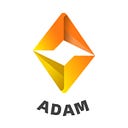ADAM data encryption computing network and blockchain digital identity authentication
“Identity” is the imprint that everyone is born with. Identity is a necessary condition for the formation of an organization. In the real world, an institutional proof of identity is usually given in the form of cards through physical media. In recent years, with the rapid development of the Internet, the form of identity has gradually transitioned from physical to virtual, digital, and networked. How to build a deterministic and credible identity in the digital age has become an urgent need for the public to discuss. The decentralized identity (DID) that uses blockchain as the underlying technology has emerged at this time.
On 17 October 2022, Bloomberg reported that South Korea plans to make digital identities protected by blockchain available to the public in 2024 and seeks to be adopted by 45 million people within two years. According to this plan, the government will not have access to information stored on individuals’ mobile phones, including details of whose digital IDs are used, how and where they are used and where, because the system will rely entirely on decentralised digital identities based on blockchain technology.
The underlying layer of a decentralised digital identity, or DID for short, is a global key-value pair database. the DID identifier is the key and the DID document is the value. In the DID identifier, the example field indicates that this database is either some DID-compatible blockchain, DID-compatible distributed ledger, or DID-compatible decentralised network.
The DID identifier is a special string, which is unique in the whole network, and can be separated, parsed, encrypted and verifiable.
Since the beginning of the Internet, digital identity has been in a constant state of development and transformation. By now, it is widely recognised that there have been four stages in its development, completing the transition from collectivised to individualised storage subjects, from centralised to decentralised data control, from centralised identity to federated identity and user-centred identity, and gradually towards autonomous sovereignty (distributed digital identity).
At a technical level, the distributed digital identity system builds a decomposable structure of identifiers and credentials, the core of which is the creation of a globally unique identity. The blockchain-based architecture supports user nodes to join the chain and manage their own data through access rights, thus realising the idea of distribution.
It can be seen that distributed digital identity is bursting with energy on a global scale with a new identity authentication mode in the context of the new era. ADAM, as the first Web3.0-based data encryption computing network, is actively exploring it, and In-depth research is also being conducted on identity authentication, data confirmation, data circulation and transactions.
Blockchain-based digital identity verification is a fundamental tactic and innovative technological breakthrough designed by ADAM for data credit. In the ADAM data encryption computing network, there is no entanglement with the concept of true or false assessment. Digital identity authentication and information traceability will be obtained for digital collections or related persons (including the subject matter, various associated persons, and time-stamped transmission information). The nodes, as system participants, have real digital asset transaction records in ADAM and will generate real-time digital identity on-chain interaction information at different stages.
In addition, ADAM has created a DAO governance community, not only for the initial digital assets (tokens, NFT, etc.) to enter the history of information transfer, value exchange records, but also with a digital identity, greatly increase the transparency of institutions, the behavior of all parties involved, improve the traceability of the system, reduce the cost of trust in the system, and introduce the traditional thinking operation to the digital economy mode. The aim is to create a more inclusive data trading market to remove the shackles of a captive market and ultimately cultivate the soil of consensus and the seas of the digital economy.
From the perspective of Web3.0, as a product of the integration of the concept of value interconnected users, it contains distributed characteristics, and the importance of distributed digital identity is self-evident. However, despite the rapid development of distributed digital identities in recent years, the participation of commercial entities and applications have also gradually increased. At present, due to its broad coverage and diverse integration, the technology and its supporting system still need to be improved, especially in terms of identity privacy protection. At the same time, it also needs to be considered that the current data independent business application model of blockchain and digital identity is contrary to the current mainstream, and its application field and coverage still need to be expanded.
